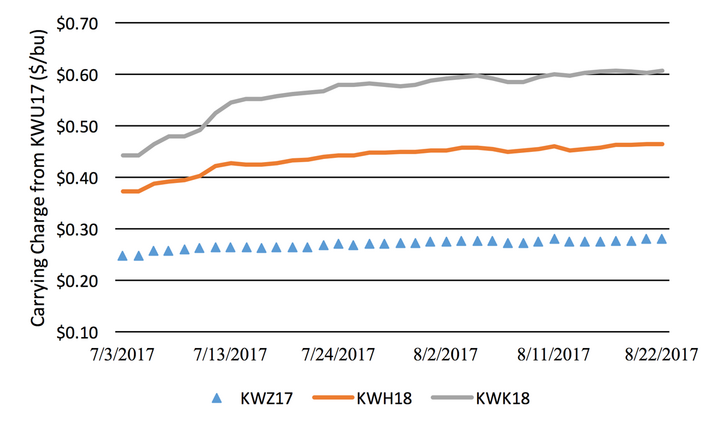Similar to the 2014/15 and the 2015/16 hard red winter (HRW) wheat marketing years, 2017/18 has started with high prices at harvest that have declined since then. Some of this price decline may be recaptured by pricing grain in on-farm storage for future delivery.
Commodities that are traded on the futures market have multiple contracts being traded at once. Kansas City hard red winter wheat market has five contracts per year: March, May, July, September and December. Figure 1 shows the futures market prices for the September 2017 (KWU17), December 2017 (KWZ17), March 2018 (KWH18), and May 2018 (KWK18) HRW wheat from July 3, 2017 to August 22, 2017.
Figure 2 and Table 1 show that despite this decline in contract prices, abundant supplies in the hard red winter wheat market have caused positive and growing differences between KWU17 and KWZ17, KWH18 and KWK18.
These differences between contracts are often called “carrying charges” or “spreads.” Carrying charges may provide opportunities for those with unpriced HRW wheat in on-farm storage to obtain higher prices for their grain. To capture this carrying charge, you can use a cash-forward contract or a hedge-to-arrive (HTA) contract.
Before selling wheat using one of these contracts, decide if the carrying charge is sufficient enough to cover the variable expenses of additional storage.
To do this we will compare the interest cost of holding grain with the carrying charge. For this example, let’s assume that your operating note interest rate is 4.5%. You call your local grain buyer who is offering the cash prices and delivery dates listed in Table 2. (Note: Your elevator may offer more than one delivery option per contract. Make sure you know the specific delivery dates for each cash price they are quoting.)
The carrying charge is calculated by subtracting the current price from the deferred price.

The carrying charge between delivering on Aug. 22, 2017 and Dec. 1, 2017 is $0.28/bu.

To calculate the interest cost of storage, multiply the current cash price by the annual interest rate of your operating note, and the number of months of additional storage. (For example, if you have an interest rate of 4.5%, you would multiply by 0.045.) Divide that answer by 12 to obtain the interest expense.

The interest expense between delivery on Aug. 22, 2017 and Dec. 1, 2017 is $0.03/bu.

Finally, the carrying charge is divided by the interest expense. If this ratio value is greater than 1.40, the carrying charge is sufficient to cover the additional expenses of storage. The larger the ratio, the more profitable the carry.

The carrying charge to interest expense ratio between Aug. 22, 2017 and Dec. 1, 2017 is 9.33.

In the example shown in Table 2, the most profitable decision is to price wheat today for December delivery. However, given the conditions of the example, delivering in May is more profitable than delivering in March.
It is important to remember that other factors besides price may determine your storage decisions. Crop quality, truck availability, and labor availability also may factor into your decision.
Like all elements of grain marketing, carrying charges change quickly. If you see a profitable carrying charge, lock in the price now because in a few days conditions may cause these returns to storage to disappear.

Note: KW is the Kansas City Board of Trade notation for the hard red winter wheat market, the letter following KW represents the delivery month of the contract: N-July, U-September, Z-December, H-March, and K-May.

| KWU17 | KWZ17 | KWH18 | KWK18 |
|---|---|---|---|
| Price | ---Carrying Charge--- | ||
| $3.99 | $0.28 | $0.47 | $0.61 |
| Current Price | December Deferred Price | March Deferred Price | May Deferred Price | |
|---|---|---|---|---|
| Cash Price | $2.99 | $3.27 | $3.46 | $3.60 |
| Delivery Date | 8/22/2017 | 12/1/2017 | 3/1/2018 | 5/1/2018 |
| Carrying Charge | $0.28 | $0.47 | $0.61 | |
| Interest Expense | $0.03 | $0.07 | $0.09 | |
| Carrying Charge vs. Interest Expense | 9.33 | 6.64 | 6.75 |
- Current Price
- Deferred Price
- Operating Note Interest Rate
- Months In Storage
- Interest Expense
- Carrying Charge
- Ratio ', data: { deferredPrice: 3.27, currentPrice: 2.99, operatingNoteInterestRate: 4.5, monthsInStorage: 3, analyticsEvent: false, }, computed: { carryingCharge: function(){ return (this.deferredPrice - this.currentPrice).toFixed(2); }, interestExpense: function(){ return (( this.currentPrice * (this.operatingNoteInterestRate / 100) * this.monthsInStorage ) / 12).toFixed(3); }, ratio: function(){ return (this.carryingCharge / this.interestExpense).toFixed(1); } }, watch: { deferredPrice: function(){ if(!this.analyticsEvent){ ga('send', 'event', 'Calculator', 'GrainHoldingCalculator', document.URL); this.analyticsEvent = true; } }, currentPrice: function(){ if(!this.analyticsEvent){ ga('send', 'event', 'Calculator', 'GrainHoldingCalculator', document.URL); this.analyticsEvent = true; } }, operatingNoteInterestRate: function(){ if(!this.analyticsEvent){ ga('send', 'event', 'Calculator', 'GrainHoldingCalculator', document.URL); this.analyticsEvent = true; } }, monthsInStorage: function(){ if(!this.analyticsEvent){ ga('send', 'event', 'Calculator', 'GrainHoldingCalculator', document.URL); this.analyticsEvent = true; } } } }); }); });

